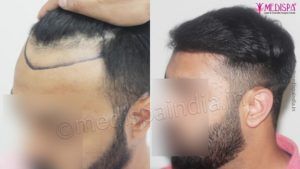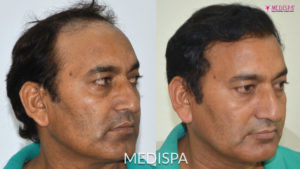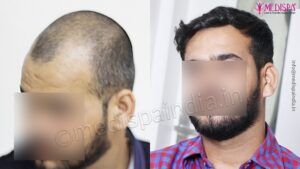
India is renowned for its rich cultural heritage, magnificent monuments, and exquisite sculptures, which have captivated the interest of the Western world, enticing them to visit at least once in their lifetime. However, with the rapid advancement of technology in the country, India has also gained recognition for its world-class medical facilities.
In a similar vein, the field of hair transplant in India has made significant strides in terms of advancements, establishing itself as a sought-after destination for hair transplant tourism. The procedure of hair transplant, like any other cosmetic surgery, requires not only exceptional surgical skills but also an artistic vision to create a beautifully natural hairline. Indian surgeons possess a unique artistic sensibility inherited from their ancestors, which has propelled them to be recognized as some of the finest hair transplant surgeons in the world.
What are the solutions for hair loss issue?
The problem of hair loss is now being addressed through various strategies, which are explained as follows:
- Temporary measures: There are options such as wigs, extensions, and prosthetic hairs that can temporarily hide hair loss. However, these measures require regular maintenance and replacements due to their temporary nature. The frequent maintenance can be quite exhausting, making it an impractical choice for long-term usage. Additionally, these measures do not provide a natural look, which can be embarrassing if someone notices them.
- Medications: In the market, there are medications available like Minoxidil and finasteride that aim to treat hair loss. These medications are known to slow down the progression of hair loss and promote faster hair growth. However, the outcomes of these medications are unpredictable and may or may not benefit every individual. Moreover, the results can be temporary, as the condition may relapse once the medication is discontinued. Therefore, relying solely on medications may not be a feasible long-term solution for managing hair loss.
- Hair transplantation is considered the final and ultimate solution for individuals facing hair loss. This surgical procedure involves extracting hair grafts from donor areas of the body and transplanting them to the bald areas where hair growth is desired. It is important to consult with a skilled hair transplant surgeon to determine if you are a suitable candidate for this procedure.
Hair transplant
Hair transplant surgery is a cosmetic procedure done on an outpatient basis, which entails implanting permanent hair roots into the bald area. These roots are taken from the patient’s own body and go through the same growth cycle as the existing hair. The feasibility of the surgery can be determined during the initial consultation through a comprehensive evaluation of the patient’s condition.
Hair transplantation is carried out using two distinct methods, with the procedures being similar except for the way grafts are harvested.
- The FUT hair transplant technique, also known as Follicular Unit Transplantation or strip technique, involves harvesting a thin strip of scalp tissue from the back or side of the head, or alternatively from body hairs. This strip is carefully dissected in the graft separation room to obtain individual hair grafts, which consist of hair follicles and surrounding tissues. These follicular units are then transplanted to the recipient bald site, with each step performed under high magnification to ensure the best possible survival of the grafts.
- The FUE hair transplant technique, or Follicular Unit Extraction, involves the individual extraction of follicular grafts using a surgical device with varying diameters. These extracted follicular units are then transplanted to the desired recipient bald site, providing a natural and effective solution for hair restoration.
The selection of techniques is determined by the unique circumstances of each patient. Various factors must be considered in order to choose the most suitable technique for the patient’s well-being, such as the extent of baldness, the patient’s age and gender, the number of follicular grafts needed, and the quality and quantity of hair follicles in the donor area. The decision on which technique to use is primarily based on the number of grafts required, as the FUT hair transplant technique can cover a larger bald area by allowing for the harvesting of a greater number of grafts. While both techniques have their own advantages, the advanced FUT technique offers several additional benefits, making it the preferred choice in many cases.
Hair restoration surgery is a highly sought-after cosmetic procedure in Delhi, renowned for housing some of the best hair transplant specialists globally. Patients travel from various parts of the world to undergo hair transplant procedures performed by leading surgeons in the capital. The hair transplant cost in India has significantly decreased due to the competitive nature of the industry.
Medispa hair transplant clinic stands out as a premier destination for hair transplant procedures in India, renowned for delivering exceptional results. Boasting the country’s most skilled and extensive hair transplant team, our clinic is dedicated to ensuring every patient receives a superior hair transplant experience. Dr. Suneet Soni is highly esteemed as one of India’s leading hair transplant specialists, recognized for his innovative approach to hairline design.
Is hair transplantation the best option for treating pattern baldness?
- Undoubtedly, hair transplantation stands out as the most effective solution for pattern baldness. The benefits of this procedure include:
- The effects of hair transplantation are long-lasting. If the procedure is performed correctly, the hair growth achieved through a hair transplant will be permanent.
- Hair transplant surgery is a swift and painless process. Once you have fully recovered physically, there is no need for any additional steps to promote hair growth.
- Local anesthesia is administered during this painless procedure, ensuring a comfortable experience.
- The use of your own hair in the transplant results in a natural-looking hairline.






